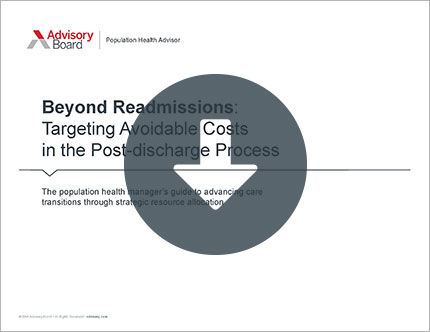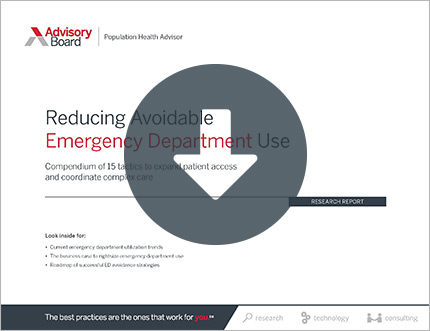Auto logout in seconds.
Continue LogoutRead Advisory Board's take: What does this study mean for the program?
Declines in risk-adjusted readmissions under the Hospital Readmissions Reduction Program (HRRP) may be overstated and explained in part by a change in coding rules—rather than an actual decline in readmissions—according to a study published Monday in Health Affairs.
The ACA's Hospital Readmissions Reduction Program (HRRP), implemented in 2012, aims to reduce the number of patients who are readmitted to the hospital within 30 days of discharge for several conditions. Several studies in recent years have suggested the program is working as intended, but the new research suggests coding changes CMS made between 2010, when the program was created, and 2012, when providers began facing penalties may explain the quick decline in readmission rates recorded in 2011.
What was responsible for the reduction in hospital readmissions?
The researchers noted that between March 2010 and October 2012 CMS changed its coding standards, allowing providers to submit up to 25 diagnosis codes per Medicare claim. Prior to 2011, providers were only able to submit nine to 10 diagnosis codes.
The researchers found the coding change correlated with a change in the number of diagnosis codes hospitals submitted on inpatient claims. They found that 81% of hospital admission claims in November 2010, before CMS' coding change was in effect, reported nine or 10 diagnoses. However, that number fell to 15% in January 2011, and 70% of admission claims featured 11 or more diagnoses.
The research noted that increase in reported diagnosis codes affected the risk-adjustment calculation CMS uses to determine changes in readmission rates. Since the number of comorbidities per patient rose, the HRRP calculation methodology assumed that patients were more likely to be readmitted to the hospital. Therefore, the control risk-adjusted readmission rate (without the HRRP program) increased, making more limited hospital improvements in readmission rates appear more significant.
According to the study, between April 2010 and September 2012, declines in readmissions were 48% smaller when risk adjustment looked at nine or fewer diagnoses codes versus 11 or more diagnoses codes. HRRP hospitals did not show larger decreases in readmission rates compared to other hospitals.
What role did HRRP play?
Christopher Ody, lead author of the study and a research assistant professor for the Kellogg School of Management at Northwestern University said the results of the new study "pull the rug" out of claims that HRRP played a major role in the reduction of readmission rates.
Ody said there are two "pieces of evidence that had been used to say that [HRRP] had had a big effect," on the reduction in readmission rates: "One was this really dramatic time series decrease and the other one is these decreases were bigger for targeted conditions and targeted hospitals." Ody said the new study challenges both of those explanations.
"If you asked me what I thought, the most likely interpretation of our results would be that [the HRRP] didn't work. And the reason for that is that I don't think that there is any reason that there should be decreases in readmission rates in critical access hospitals because of this program," he says.
The study is the second in the past year to argue that the reduction in readmissions rates are due to coding changes instead of HRRP, Modern Healthcare reports. Another study, published in February 2018 in JAMA, reported that 63% of the reduction in hospital readmission rates in the HRRP program are due to coding changes.
"Even though [the studies] are different methods, the punchline is still the same," said Andrew Ibrahim, lead author of the JAMA study and surgeon at University of Michigan. At best the hospital readmissions program reduced readmissions in maybe half the magnitude we think."
A spokesperson for CMS said the agency is reviewing the most recent study results (Castellucci, Modern Healthcare, 1/7; Kuhrt, FierceHealthcare, 1/7; Ody, Health Affairs, January 2019).
Advisory Board's take

Eric Fontana, Managing Director, Data and Analytics Group and Kenna Hawes, Senior Data Analyst, Data and Analytics Group
Many previous studies have associated the onset of the Hospital Readmissions Reduction Program (HRRP) with a reduction in risk-adjusted 30-day readmission rates at participating hospitals, which would suggest that the program is working. In fact, of the three mandatory inpatient pay-for-performance programs, the HRRP is the only one that is widely believed to be achieving its goal.
“Of the three mandatory inpatient pay-for-performance programs, the HRRP is the only one that is widely believed to be achieving its goal.”
However, some researchers have raised concerns that the demonstrated reduction in readmission rates over the program's first five years does not entirely reflect a reduction in readmissions, but rather is attributable to changes in documentation practices or standards. The work of Ody et al. supports this concern.
At first glance, the HRRP's mechanism appears to be fairly straightforward: Reduce readmissions for select high-cost, high-volume conditions through better care and post-discharge coordination. However, Ody et al. remind us that even a seemingly simple quality indicator like a hospital’s risk-adjusted 30-day readmission rate could be influenced by elements ranging from documentation standards to social factors impacting that hospital's patient population—and many of these relationships are poorly understood. Furthermore, it is unclear how low 30-day risk-adjusted readmission rates should be for these conditions. These outstanding questions support the need for CMS to test and validate models like the HRRP before rolling them out as mandatory programs, with financial impact, nationwide.
This study comes two weeks after another study of the HRRP published in JAMA, which questions whether the HRRP is in fact resulting in worse patient outcomes. It will be interesting to see whether CMS and MedPAC, which have maintained that the HRRP is succeeding, respond to these researchers' concerns.
Get your cardiovascular readmission reduction toolkit
Reducing your hospital's readmission rates can seem like an overwhelming task—but it doesn't have to be.
Knowing where to focus is half the battle. We've found that the best strategies target four stages of care with significant potential to influence cardiovascular patient outcomes. The other half is knowing what improvements to make.
That's where our Readmission Reduction Toolkit comes in. We've compiled resources from across Advisory Board that will help you isolate and correct patient and systemic issues in the four critical stages of care:
Stage 1: Transition planning during the inpatient stay
Stage 2: Discharge education
Stage 3: Post-acute care coordination
Stage 4: Transitional care support
Don't miss out on the latest Advisory Board insights
Create your free account to access 1 resource, including the latest research and webinars.
Want access without creating an account?
You have 1 free members-only resource remaining this month.
1 free members-only resources remaining
1 free members-only resources remaining
You've reached your limit of free insights
Become a member to access all of Advisory Board's resources, events, and experts
Never miss out on the latest innovative health care content tailored to you.
Benefits include:
You've reached your limit of free insights
Become a member to access all of Advisory Board's resources, events, and experts
Never miss out on the latest innovative health care content tailored to you.
Benefits include:
This content is available through your Curated Research partnership with Advisory Board. Click on ‘view this resource’ to read the full piece
Email ask@advisory.com to learn more
Click on ‘Become a Member’ to learn about the benefits of a Full-Access partnership with Advisory Board
Never miss out on the latest innovative health care content tailored to you.
Benefits Include:
This is for members only. Learn more.
Click on ‘Become a Member’ to learn about the benefits of a Full-Access partnership with Advisory Board
Never miss out on the latest innovative health care content tailored to you.


